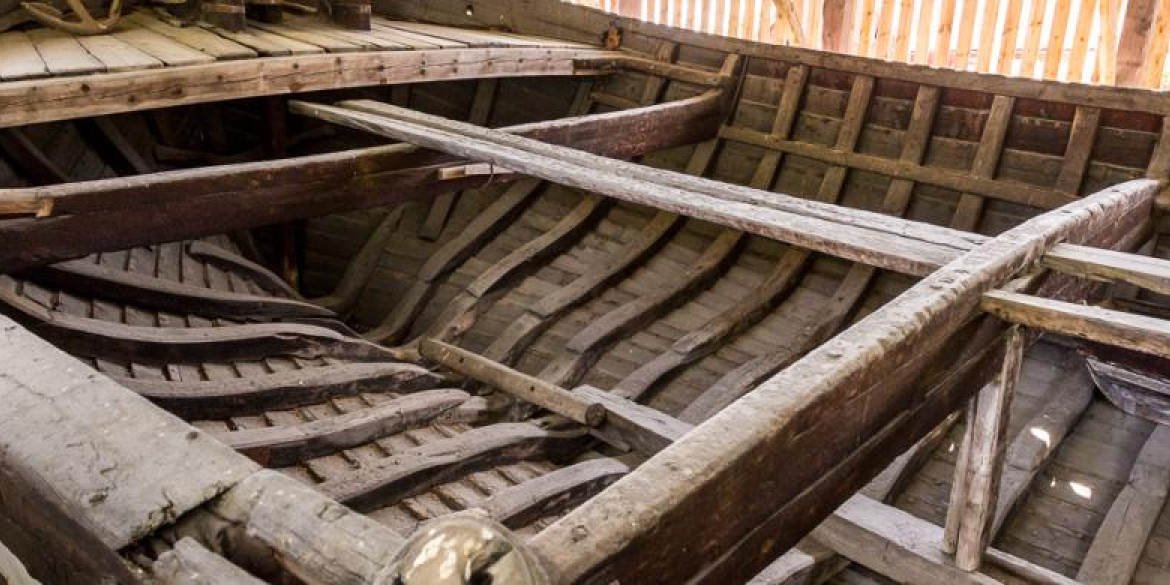A jekt is a small but wide single-masted, square-rigged, open sailing vessel. It has a tall stem, no permanent decking, and a flat stern, often with a small windowed aft compartment. Jekts have varied in size from less than 10 to more than 20 meters in length. They were used as cargo vessels all along the western coastline, from Hardanger in the south to Finnmark in the north. Bergen was usually the final destination. Coastal villages had fish to sell, while fjord communities traded in timber and firewood. This boat type probably replaced the most common Viking Age cargo and merchant vessel, the knarr.
Holvikejekta was built in 1881 at Krånafjøra in Sandane by brothers Jakob and Andreas Apalset. The metalwork was done by Elias Andenes. The jekt is 20 meters long and 8.6 meters wide. The mast was 26.5 meters tall with a 14-meter yard. The anchor was fastened near the bow, while the crew compartment with its bunks, table and stove is located in the stern. There is a deck atop the compartment, used by the crewmember steering the vessel. The main sail was raised using a double tackle, where the bottom tackle was fixed to the boat. (They eventually switched to a winch system for hoisting sail).
The owners of Holvikejekta were; Abraham Pederson Holvik (b. 1849), a farmer from Holvik in Sandane; Ole Jensson Austrheim (b. 1856), at Jens-Olabruket in Austrheim; Ola Larsson Eide (b. 1865), at farmstead no. 5; and Reiel Andersson Andenes (b. 1844), a farmer at Martinsbruket.
Cargo
Holvikejekta was used for transporting timber and firewood to Bergen. It had room for about 120 favn of firewood (1 favn = about 2.2 m3). If the wood had been chopped the year before, it would weigh less, and they once managed to carry as much as 150 favn. To accommodate such large volumes, stakes supporting upright wooden boards were placed along the sides of the hull. Ropes were fastened to the stakes near the top and stretched across the boat to secure the temporary construction.
In addition to firewood, it was common to carry other raw materials, barrel hoops, bast rope, birch bark, barrels and chests, woven clothing and other homemade products to sell in the city. Children could sell pine cones or materials for tinder and kindling. They could also bring larger cargo, like mast poles or smaller faering boats, and even live animals. If needed, room was made in amongst the bundled firewood. Larger items were always things that had been ordered in advance, while the firewood was sold on the open market.
Bergen
In Bergen, they sold their cargo and purchased goods needed back home. This was also an opportunity to get any official business done, visit family and friends, or partake in the city’s nightlife. The skipper was responsible for settling and keeping track of the various trades. Coming back from Bergen, the cargo could consist of goods like white flour, sugar, salt, grindstones, clothing and roof tiles. It was common to make two or three trips to Bergen each year, with a crew of five to six people.
Obsolete
Once motorised boats were common, the jekts became obsolete. Some had their rigs removed and were fitted with engines, others were rebuilt, while most were sunk, burnt, dismantled or simply abandoned. Holvikejekta was brought ashore at Øyrane in 1906, and its mast, sails, winch and anchor chains were sold off. The history society in Nordfjord bought the jekt in 1909, and when they founded the Nordfjord Museum of Cultural History in 1920, this was the first object in their collection.
Only preserved clinker-built jekt
Of the many hundreds of jekts that hauled cargo to Bergen, Holvikejekta is the only preserved clinker-built jekt. The clinker-build is an ancient construction method where the edges (seams) of the hull planks overlap and are fastened together using iron nails. These are special rivets that are knocked through from the outside and then clenched over roves on the inside of the hull. The outer hull – the skin – was built first, giving the boat its shape. The inner layer was built afterwards, and attached to the skin using nails. (This distinguishes clinker-builds from the newer carvel-builds, where one constructed and shaped the inner layer first, before adding the outer skin).

